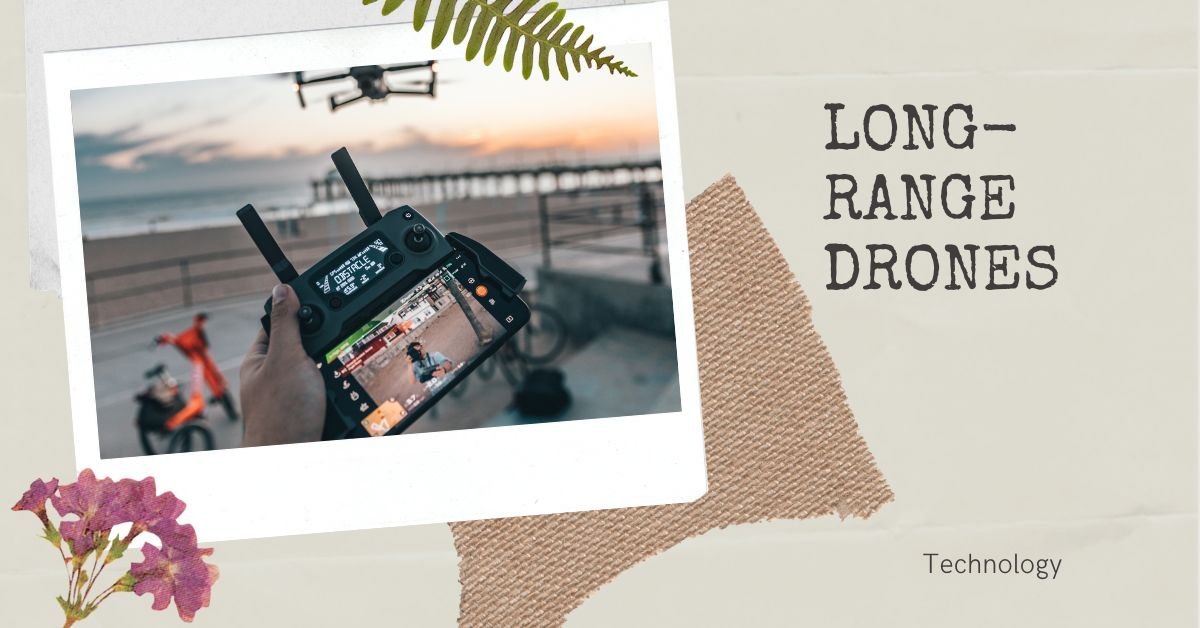
Long Range Drones: An All-Inclusive Handbook for Drone Operators
Any drone intended for long-distance flight is considered long-range drone.
The range of a drone simply refers to its flying distance. Additionally, it can significantly affect its potential utility for specific tasks, including as search and rescue operations, industrial inspections, and aerial photography.
2024’s Top Long-Range Drones
These are some of the best long-range drones available, with varying price ranges and features. Every drone is evaluated according to its overall benefits and drawbacks, maximum range, flight duration, camera quality, and unique features.
Thanks to its OcuSync 3.0 transmission system, the DJI Mavic 3 has a maximum range of 9.3 miles (15 kilometers), making it one of the best long-range drones available.
The Mavic 3 is perfect for prolonged aerial photography sessions because it can fly for up to 46 minutes. 5.1K video resolution and a 20 MP camera with a 4/3 CMOS sensor are included for taking excellent pictures.
Advantages: Long flight duration, excellent camera quality, and long range.
The Autel EVO Lite+ is a multipurpose long-range drone that falls somewhere between hobbyist and professional.
It can fly for up to 40 minutes and has a maximum range of 7.5 miles (12 kilometers). The drone is a strong choice for producing high-resolution content because its 50 MP camera can capture 6K video.
Advantages: Long range, high-resolution camera and cost-effectiveness in comparison to high-end ones.
Cons: Limited support for third-party accessories and sporadic problems with app connectivity.

- 3. The DJI Mini 3 Pro
With a range of up to 7.5 miles (12 kilometers) and a flying duration of up to 34 minutes, the DJI Mini 3 Pro is a small and reasonably priced long-range drone. Its 1/1.3′′ sensor records 4K video and takes 48 MP pictures. Because it weighs less than 250 grams and does not need to be registered with the FAA, it is a practical choice for tourists.
Advantages: inexpensive, lightweight, and no registration required.
Cons: Not as reliable as larger ones, limited in heavy winds.
- USA’s Parrot Anafi
The Parrot Anafi USA is intended for professional use, particularly in inspection or search and rescue missions. Its 32-minute flight period, 2.5-mile (4-kilometer) range, and 32x zoom camera provide thorough monitoring and examination.
Advantages: Excellent for inspections, robust design, and sophisticated zoom capabilities.
Cons: More expensive and less versatile than comparable professional models.
An Overview of Long-Distance Drone History
Drone development has always placed a high priority on range. As drone technology has advanced, significant advancements in signal transmission, battery life, and range have also affected range.
The following is a chronology of significant advancements in long-range drone technology:
1940s through 1960s. During World War II and the Cold War, early drone technology developed, mostly for military target practice and reconnaissance missions.
the 1980s. Longer-range communication technologies and sophisticated navigation systems were first used by military drones for surveillance, opening the door for later developments in the consumer sector.
The 1990s saw the development of defense drones like the MQ-1 Predator, which could fly hundreds of miles for combat and surveillance operations. These developments paved the way for civilian drones to have extended range.
In the 2000s, firms such as DJI began to introduce drones for amateurs, marking the beginning of the consumer drone business. Because to technology limitations and regulatory concerns, Long-Range Drones capabilities were still restricted.
2010s. Consumer drones may now reach ranges of several kilometers thanks to advancements in GPS, radio frequency transmission, and battery technology. For Long-Range Drones aerial photography and cinematography, DJI’s Phantom series gained popularity.

2015–2018. Long-distance flying became safer when consumer drones started integrating military-inspired features like autonomous flight modes and sophisticated obstacle avoidance.
How Do Drones Operate?
Numerous technological elements, including as navigation systems, onboard power management, and signal transmission techniques, affect Long-Range Drones. Optimizing a drone performance and range requires an understanding of how these parts interact.
The following six major elements affect a drone’s range of flight:
- Transmission of Signals
A drone’s signal transmission method is the main determinant of its range.
Drones communicate with their remote controllers via a variety of techniques:
RF stands for radio frequency. The majority of drones broadcast and receive signals via radio frequency (RF) transmission in particular frequency ranges, such as 2.4 GHz or 5.8 GHz. Although these frequencies have a range of many kilometers, physical obstacles or interference from other electronic devices may reduce that range.
WiFi. Wi-Fi is used by several consumer drones for short-range communication. Despite being less expensive, Wi-Fi often has a shorter range than specialized RF transmission technologies.
Both Lightbridge and OcuSync. DJI created exclusive technologies like Lightbridge and OcuSync that increase drone range to more than 10 kilometers using sophisticated digital transmission. To lessen interference, these systems have capabilities like adaptive transmission and automatic frequency band change.
Life of Batteries and Power Usage
A Long-Range Drones is largely determined by its power management.
To keep up flight over longer distances, long-range drones require effective batteries and power systems. Speed, camera usage, altitude, and other variables affect power consumption, which shortens the battery’s useful range and causes it to drain more quickly.
Recent developments in lithium-polymer (LiPo) and lithium-ion (Li-ion) batteries have greatly extended flight durations, which has an indirect impact on range since it allows the drone to travel farther between charges.
- Aerodynamic Design and Drone Weight
The drone’s weight and design affect how well it can fly. Drones that are heavier have a shorter range since they need more power to stay in the air. Additionally, aerodynamic designs reduce drag and increase the drone’s range between charges.

Flight Capabilities on Their Own
In order to securely increase their operational range, modern drones frequently have autonomous flight features like “Return to Home” (RTH) and automatic waypoint navigation.
By enhancing effective range and lowering the possibility of flying beyond the pilot’s control, these characteristics enable the drone to fly pre-programmed routes or automatically return if the signal is lost.
- Regulatory Restrictions
How far a drone can fly can also be impacted by legal restrictions on drone activities, such as altitude limits or line-of-sight regulations. Drones are only allowed to fly within visual line of sight in the United States, which means that their range is limited to 1-2 miles.
Environmental Elements
The range of a drone can be greatly impacted by outside factors like topography, weather, and interference. Strong winds or rain increase power usage, while buildings or other electronic devices may interfere with signals, reducing transmission distance. The signal may also be interfered with when flying over a variety of terrain, such as mountains or thick forests.
Regulations Concerning Long-Distance Flying
Complying with FAA regulations is essential while operating long-range drones in the United States.
Here are the essential details to be aware of:
- BVLOS Rules
The FAA’s Part 107 regulations which mandate that the operator maintain the drone inside their visual line of sight often limit drone flying beyond the line of sight. A waiver is required in order to operate drones across large distances. Pilots must exhibit precautions to ensure safe operation, such as employing cutting-edge detect-and-avoid technology or maintaining a network of visual observers, before they can be granted a waiver.
- Limitations on Maximum Altitude
For the majority of drone operations, the FAA establishes a maximum altitude of 400 feet above the ground.
Operators of long-range drones are required to adhere to this altitude restriction, unless they are operating close to large structures or greater altitudes are expressly allowed with a waiver.

- Commercial vs. Recreational Drone Use
Commercial and recreational drone pilots are subject to different regulations.
While commercial pilots may request waivers to use BVLOS, recreational pilots are required to adhere to FAA safety regulations and fly within visual line of sight. Additionally, in order to legally use drones for business purposes, commercial pilots must get a Part 107 Remote Pilot Certificate. By following these guidelines, penalties and legal problems can be avoided.
- 4. Getting Long-Range Operations Waivers
Commercial pilots who want to use long-range drones must get an FAA BVLOS waiver.
It can take a while to receive a waiver because the application is comprehensive. Details about the pilot’s safety measures during operations, such as employing technology to prevent collisions and having emergency plans, are included in successful applications. The likelihood that a waiver will be granted is increased by proving compliance with other rules and an understanding of the airspace.
13 Best Uses for Long-Distance Drones
Current VLOS regulations, which we briefly discussed above, notwithstanding, new developments in Beyond Visual Line of Sight (BVLOS) technology are opening up new use cases.
Additionally, we may anticipate a huge increase in commercial applications that fully utilize expanded flying ranges after the FAA completes its Part 108 rule for BVLOS operations.
These are thirteen primary applications for long-range drones.
- 1. Search and Rescue Activities
Search and rescue (SAR) operations frequently take place in hazardous or isolated areas when time is of the essence. Long-range drones with sophisticated cameras and sensors may swiftly search vast regions for indications of missing people, giving emergency personnel access to real-time information and reaching locations that are inaccessible by foot or car.
Long-range SAR Use Cases
using drones equipped with infrared imaging technology to find lost individuals in mountainous or forested areas.
supplying aerial imagery of disaster areas so that rescue operations can be coordinated.
searching for survivors in places hit by landslides or floods.
Surveys of Agriculture
Farmers can evaluate crop health and identify problems like pest infestations or water stress thanks to long-range drones, which make it possible to monitor large agricultural areas effectively. Drones can gather detailed data that improves agricultural operations and boosts production by flying beyond visible line-of-sight limitations.
Inspection of Infrastructure
Critical infrastructure inspection is being revolutionized by long-range drones, which make it safer and more economical. Without requiring human inspectors to venture into dangerous regions, drones fitted with specialized sensors may identify problems in pipelines, electricity lines, and railroads over long distances.




